Anapole Modes in Hollow Nanocuboid Dielectric Metasurfaces for Refractometric Sensing
Abstract
1. Introduction
2. Methods
3. Results
3.1. Multipole Decomposition of Individual Nanoparticles
3.2. Nanostructured Metasurfaces
4. Conclusions
Author Contributions
Funding
Conflicts of Interest
References
- Rickman, A. The commercialization of silicon photonics. Nat. Photonics 2014, 8, 579–582. [Google Scholar] [CrossRef]
- Atabaki, A.H.; Moazeni, S.; Pavanello, F.; Gevorgyan, H.; Notaros, J.; Alloatti, L.; Wade, M.T.; Sun, C.; Kruger, S.A.; Meng, H.; et al. Integrating photonics with silicon nanoelectronics for the next generation of systems on a chip. Nature 2018, 556, 349–354. [Google Scholar] [CrossRef] [PubMed]
- Penadés, J.S.; Sánchez-Postigo, A.; Nedeljkovic, M.; Ortega-Moñux, A.; Wangüemert-Pérez, J.G.; Xu, Y.; Halir, R.; Qu, Z.; Khokhar, A.Z.; Osman, A.; et al. Suspended silicon waveguides for long-wave infrared wavelengths. Opt. Lett. 2018, 43, 795–798. [Google Scholar] [CrossRef] [PubMed]
- Rong, H.; Liu, A.; Jones, R.; Cohen, O.; Hak, D.; Nicolaescu, R.; Fang, A.; Paniccia, M. An all-silicon Raman laser. Nature 2005, 433, 292–294. [Google Scholar] [CrossRef] [PubMed]
- Miller, D.M.; Jokerst, N.M. Flexible silicon sensors for diffuse reflectance spectroscopy of tissue. Biomed. Opt. Express 2017, 8, 1512–1524. [Google Scholar] [CrossRef] [PubMed]
- Xia, J.; Rossi, A.M.; Murphy, T.E. Laser-written nanoporous silicon ridge waveguide for highly sensitive optical sensors. Opt. Lett. 2012, 37, 256–258. [Google Scholar] [CrossRef] [PubMed]
- Fu, Y.H.; Kuznetsov, A.I.; Miroshnichenko, A.E.; Yu, Y.F.; Luk’yanchuk, B. Directional visible light scattering by silicon nanoparticles. Nat. Commun. 2013, 4, 1527. [Google Scholar] [CrossRef]
- Tzarouchis, D.C.; Ylä-Oijala, P.; Sihvola, A. Unveiling the scattering behavior of small spheres. Phys. Rev. B 2016, 94, 140301. [Google Scholar] [CrossRef]
- Forestiere, C.; Miano, G. Material-independent modes for electromagnetic scattering. Phys. Rev. B 2016, 94, 201406. [Google Scholar] [CrossRef]
- Algorri, J.F.; Garcia-Camara, B.; Garcia-Garcia, A.; Urruchi, V.; Sanchez-Pena, J.M. Fiber optic temperature sensor based on amplitude modulation of metallic and semiconductor nanoparticles in a liquid crystal mixture. J. Lightw. Technol. 2015, 33, 2451–2455. [Google Scholar] [CrossRef]
- Poudereux, D.; Caño-García, M.; Algorri, J.F.; García-Cámara, B.; Sánchez-Pena, J.M.; Quintana, X.; Geday, M.A.; Otón, J.M. Thermally tunable polarization by nanoparticle plasmonic resonance in photonic crystal fibers. Opt. Express 2015, 23, 28935–28944. [Google Scholar] [CrossRef] [PubMed]
- Kuznetsov, A.I.; Miroshnichenko, A.E.; Fu, Y.H.; Zhang, J.; Luk’yanchuk, B. Magnetic light. Sci. Rep. 2012, 2, 492. [Google Scholar] [CrossRef] [PubMed]
- Gómez-Medina, R.; García-Cámara, B.; Suárez-Lacalle, I.; Froufe-Pérez, L.; González, F.; Moreno, F.; Nieto-Vesperinas, M.; Sáenz, J. Electric and magnetic optical response of dielectric nanospheres: Optical forces and scattering anisotropy. Photonics Nanostruct. Fundam. Appl. 2012, 10, 345–352. [Google Scholar] [CrossRef]
- Algorri, J.F.; Garcia-Camara, B.; Conde, A.C.; Sanchez-Pena, J.M.; Benito, R.V. Optimized minimum-forward light scattering by dielectric nanopillars. IEEE Photonics Technol. Lett. 2016, 28, 2160–2163. [Google Scholar] [CrossRef]
- Luk’yanchuk, B.S.; Voshchinnikov, N.V.; Paniagua-Domínguez, R.; Kuznetsov, A.I. Optimum forward light scattering by spherical and spheroidal dielectric nanoparticles with high refractive index. ACS Photonics 2015, 2, 993–999. [Google Scholar] [CrossRef]
- Kerker, M.; Wang, D.S.; Giles, C.L. Electromagnetic scattering by magnetic spheres. J. Opt. Soc. Am. 1983, 73, 765. [Google Scholar] [CrossRef]
- Geffrin, J.; García-Cámara, B.; Gómez-Medina, R.; Albella, P.; Froufe-Pérez, L.; Eyraud, C.; Litman, A.; Vaillon, R.; González, F.; Nieto-Vesperinas, M.; et al. Magnetic and electric coherence in forward- and back-scattered electromagnetic waves by a single dielectric subwavelength sphere. Nat. Commun. 2012, 3, 1171. [Google Scholar] [CrossRef]
- Bakker, R.M.; Yu, Y.F.; Paniagua-Domínguez, R.; Luk’yanchuk, B.; Kuznetsov, A.I. Resonant light guiding along a chain of silicon nanoparticles. Nano Lett. 2017, 17, 3458–3464. [Google Scholar] [CrossRef]
- García-Cámara, B.; Algorri, J.F.; Cuadrado, A.; Urruchi, V.; Sánchez-Pena, J.M.; Serna, R.; Vergaz, R. All-optical nanometric switch based on the directional scattering of semiconductor nanoparticles. J. Phys. Chem. C 2015, 119, 19558–19564. [Google Scholar] [CrossRef]
- Algorri, J.; García-Cámara, B.; Cuadrado, A.; Sánchez-Pena, J.; Vergaz, R. Selective dielectric metasurfaces based on directional conditions of silicon nanopillars. Nanomaterials 2017, 7, 177. [Google Scholar] [CrossRef]
- García-Cámara, B.; Gómez-Medina, R.; Sáenz, J.J.; Sepúlveda, B. Sensing with magnetic dipolar resonances in semiconductor nanospheres. Opt. Express 2013, 21, 23007–23020. [Google Scholar] [CrossRef] [PubMed]
- Miroshnichenko, A.E.; Evlyukhin, A.B.; Yu, Y.F.; Bakker, R.M.; Chipouline, A.; Kuznetsov, A.I.; Luk’yanchuk, B.; Chichkov, B.N.; Kivshar, Y.S. Nonradiating anapole modes in dielectric nanoparticles. Nat. Commun. 2015, 6, 8069. [Google Scholar] [CrossRef] [PubMed]
- Gongora, J.S.T.; Miroshnichenko, A.E.; Kivshar, Y.S.; Fratalocchi, A. Anapole nanolasers for mode-locking and ultrafast pulse generation. Nat. Commun. 2017, 8, 15535. [Google Scholar] [CrossRef] [PubMed]
- Tsilipakos, O.; Tasolamprou, A.C.; Koschny, T.; Kafesaki, M.; Economou, E.N.; Soukoulis, C.M. Pairing toroidal and magnetic dipole resonances in elliptic dielectric rod metasurfaces for reconfigurable wavefront manipulation in reflection. Adv. Opt. Mater. 2018, 6, 1800633. [Google Scholar] [CrossRef]
- Wang, R.; Negro, L.D. Engineering non-radiative anapole modes for broadband absorption enhancement of light. Opt. Express 2016, 24, 19048–19062. [Google Scholar] [CrossRef] [PubMed]
- Feng, T.; Xu, Y.; Zhang, W.; Miroshnichenko, A.E. Ideal magnetic dipole scattering. Phys. Rev. Lett. 2017, 118, 173901. [Google Scholar] [CrossRef] [PubMed]
- Grinblat, G.; Li, Y.; Nielsen, M.P.; Oulton, R.F.; Maier, S.A. Efficient third harmonic generation and nonlinear subwavelength imaging at a higher-order anapole mode in a single germanium nanodisk. ACS Nano 2016, 11, 953–960. [Google Scholar] [CrossRef]
- Timofeeva, M.; Lang, L.; Timpu, F.; Renaut, C.; Bouravleuv, A.; Shtrom, I.; Cirlin, G.; Grange, R. Anapoles in free-standing III–V nanodisks enhancing second-harmonic generation. Nano Lett. 2018, 18, 3695–3702. [Google Scholar] [CrossRef]
- Basharin, A.A.; Chuguevsky, V.; Volsky, N.; Kafesaki, M.; Economou, E.N. Extremely high Q-factor metamaterials due to anapole excitation. Phys. Rev. B 2017, 95, 035104. [Google Scholar] [CrossRef]
- Liu, S.D.; Wang, Z.X.; Wang, W.J.; Chen, J.D.; Chen, Z.H. High Q-factor with the excitation of anapole modes in dielectric split nanodisk arrays. Opt. Express 2017, 25, 22375–22387. [Google Scholar] [CrossRef]
- White, I.M.; Fan, X. On the performance quantification of resonant refractive index sensors. Opt. Express 2008, 16, 1020–1028. [Google Scholar] [CrossRef] [PubMed]
- Radescu, E.E.; Vaman, G. Exact calculation of the angular momentum loss, recoil force, and radiation intensity for an arbitrary source in terms of electric, magnetic, and toroid multipoles. Phys. Rev. E 2002, 65, 046609. [Google Scholar] [CrossRef] [PubMed]
- Radescu, E., Jr.; Vaman, G. Cartesian multipole expansions and tensorial identities. Prog. Electromagn. Res. B 2012, 36, 89–111. [Google Scholar] [CrossRef]
- Savinov, V.; Fedotov, V.A.; Zheludev, N.I. Toroidal dipolar excitation and macroscopic electromagnetic properties of metamaterials. Phys. Rev. B 2014, 89, 205112. [Google Scholar] [CrossRef]
- Yu, Y.F.; Zhu, A.Y.; Paniagua-Domínguez, R.; Fu, Y.H.; Luk’yanchuk, B.; Kuznetsov, A.I. High-transmission dielectric metasurface with 2π phase control at visible wavelengths. Laser Photonics Rev. 2015, 9, 412–418. [Google Scholar] [CrossRef]
- Evlyukhin, A.B.; Fischer, T.; Reinhardt, C.; Chichkov, B.N. Optical theorem and multipole scattering of light by arbitrarily shaped nanoparticles. Phys. Rev. B 2016, 94, 205434. [Google Scholar] [CrossRef]
- Palik, E.D. (Ed.) Handbook of Optical Constants of Solids; Academic Press: New York, NY, USA, 1997. [Google Scholar]
- Kaelberer, T.; Fedotov, V.A.; Papasimakis, N.; Tsai, D.P.; Zheludev, N.I. Toroidal dipolar response in a metamaterial. Science 2010, 330, 1510–1512. [Google Scholar] [CrossRef]
- Tasolamprou, A.C.; Tsilipakos, O.; Kafesaki, M.; Soukoulis, C.M.; Economou, E.N. Toroidal eigenmodes in all-dielectric metamolecules. Phys. Rev. B 2016, 94, 205433. [Google Scholar] [CrossRef]
- Fedotov, V.A.; Papasimakis, N.; Plum, E.; Bitzer, A.; Walther, M.; Kuo, P.; Tsai, D.P.; Zheludev, N.I. Spectral collapse in ensembles of metamolecules. Phys. Rev. Lett. 2010, 104, 223901. [Google Scholar] [CrossRef]
- Yang, Y.; Wang, W.; Boulesbaa, A.; Kravchenko, I.I.; Briggs, D.P.; Puretzky, A.; Geohegan, D.; Valentine, J. Nonlinear Fano-resonant dielectric metasurfaces. Nano Lett. 2015, 15, 7388–7393. [Google Scholar] [CrossRef]
- Papasimakis, N.; Fedotov, V.A.; Zheludev, N.I.; Prosvirnin, S.L. Metamaterial analog of electromagnetically induced transparency. Phys. Rev. Lett. 2008, 101, 253903. [Google Scholar] [CrossRef]
- Liu, N.; Weiss, T.; Mesch, M.; Langguth, L.; Eigenthaler, U.; Hirscher, M.; Sönnichsen, C.; Giessen, H. Planar metamaterial analogue of electromagnetically induced transparency for plasmonic sensing. Nano Lett. 2010, 10, 1103–1107. [Google Scholar] [CrossRef] [PubMed]
- Schinke, C.; Peest, P.C.; Schmidt, J.; Brendel, R.; Bothe, K.; Vogt, M.R.; Kröger, I.; Winter, S.; Schirmacher, A.; Lim, S.; et al. Uncertainty analysis for the coefficient of band-to-band absorption of crystalline silicon. AIP Adv. 2015, 5, 067168. [Google Scholar] [CrossRef]
- Skafte-Pedersen, P.; Nunes, P.; Xiao, S.; Mortensen, N. Material limitations on the detection limit in refractometry. Sensors 2009, 9, 8382–8390. [Google Scholar] [CrossRef] [PubMed]
- Armani, A.M.; Kulkarni, R.P.; Fraser, S.E.; Flagan, R.C.; Vahala, K.J. Label-dree, single-molecule detection with optical microcavities. Science 2007, 317, 783–787. [Google Scholar] [CrossRef]
- Lee, Y.; Kim, S.J.; Park, H.; Lee, B. Metamaterials and metasurfaces for sensor applications. Sensors 2017, 17, 1726. [Google Scholar] [CrossRef] [PubMed]
- Li, C.; Bai, G.; Zhang, Y.; Zhang, M.; Jian, A. Optofluidics refractometers. Micromachines 2018, 9, 136. [Google Scholar] [CrossRef]
- Prabowo, B.; Purwidyantri, A.; Liu, K.C. Surface plasmon resonance optical sensor: A review on light source technology. Biosensors 2018, 8, 80. [Google Scholar] [CrossRef]
- Zografopoulos, D.C.; Asquini, R.; Kriezis, E.E.; d’Alessandro, A.; Beccherelli, R. Guided-wave liquid-crystal photonics. Lab Chip 2012, 12, 3598–3610. [Google Scholar] [CrossRef]
- Zografopoulos, D.C.; Kriezis, E.E.; Beccherelli, R. Design of switchable guided-mode resonant filters in zenithal-bistable liquid-crystal gratings. IEEE Photonics Technol. Lett. 2017, 29, 1367–1370. [Google Scholar] [CrossRef]
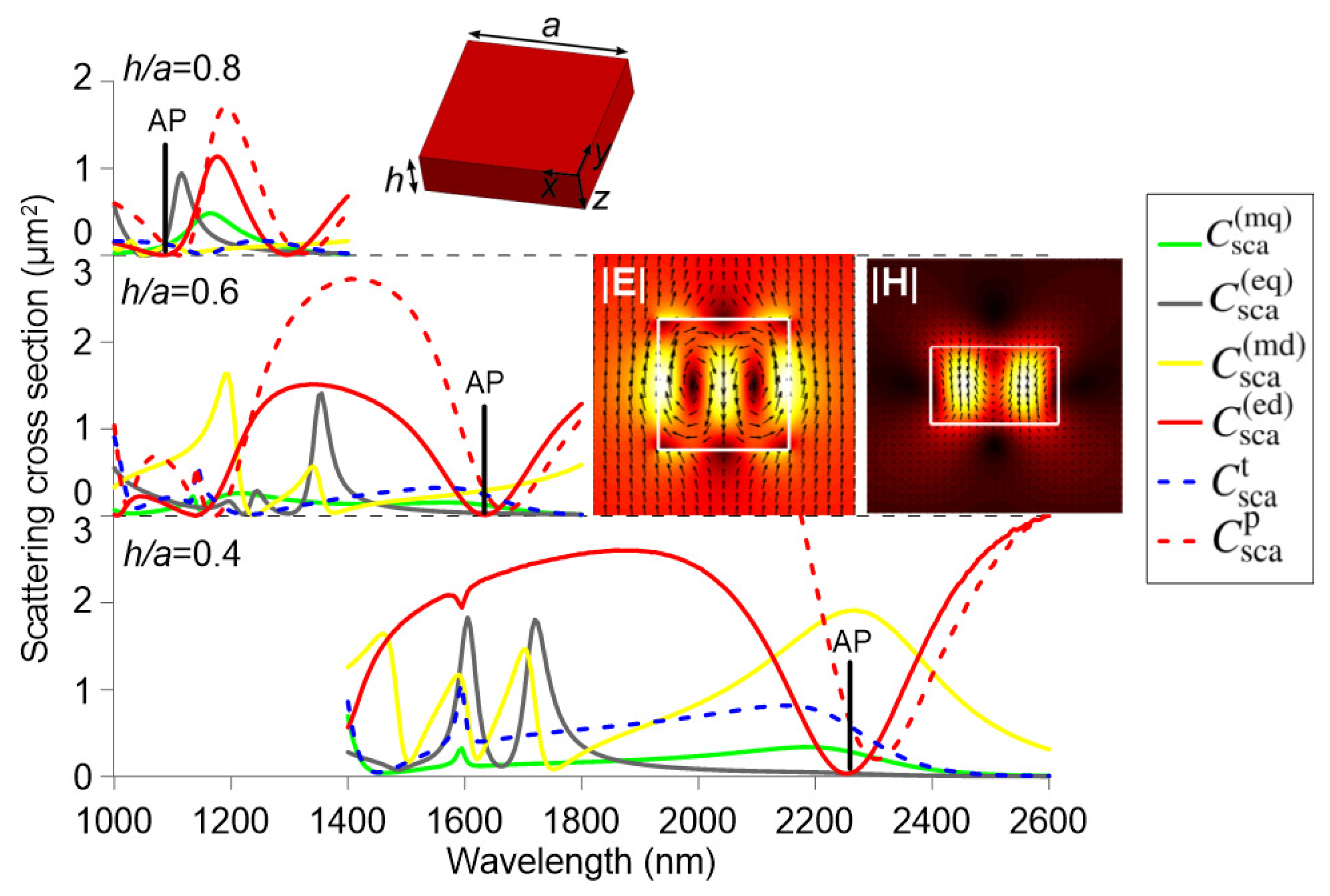

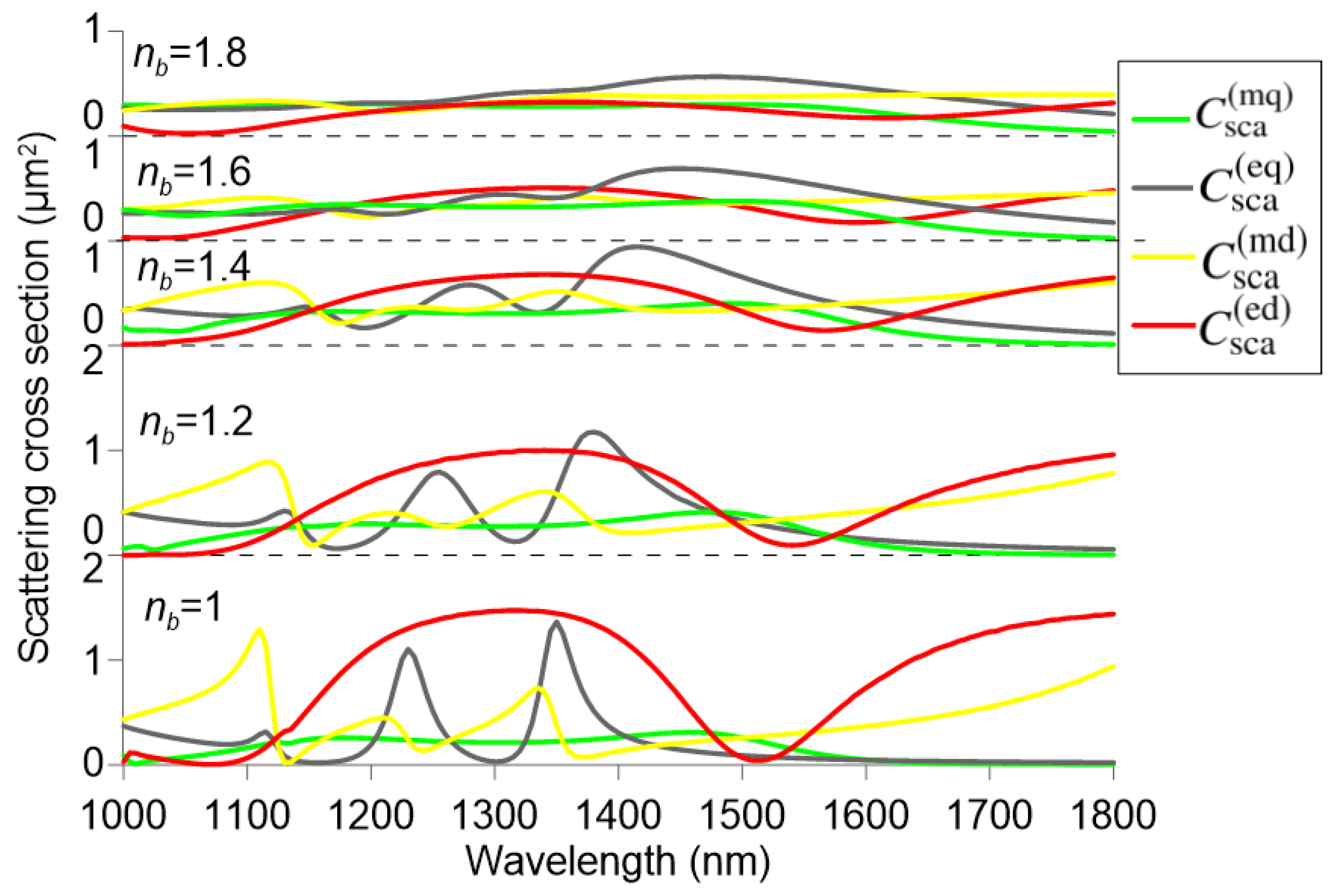
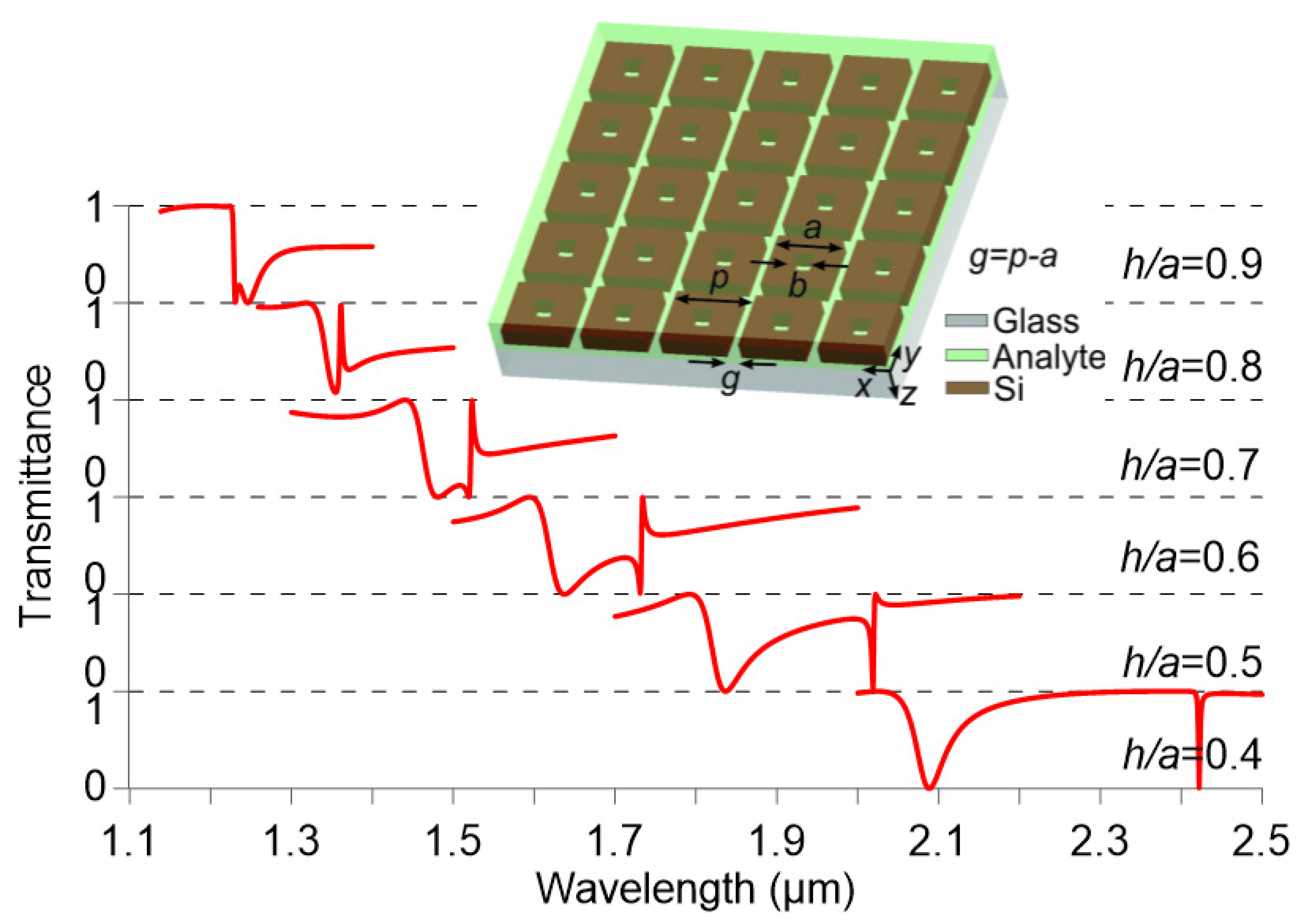
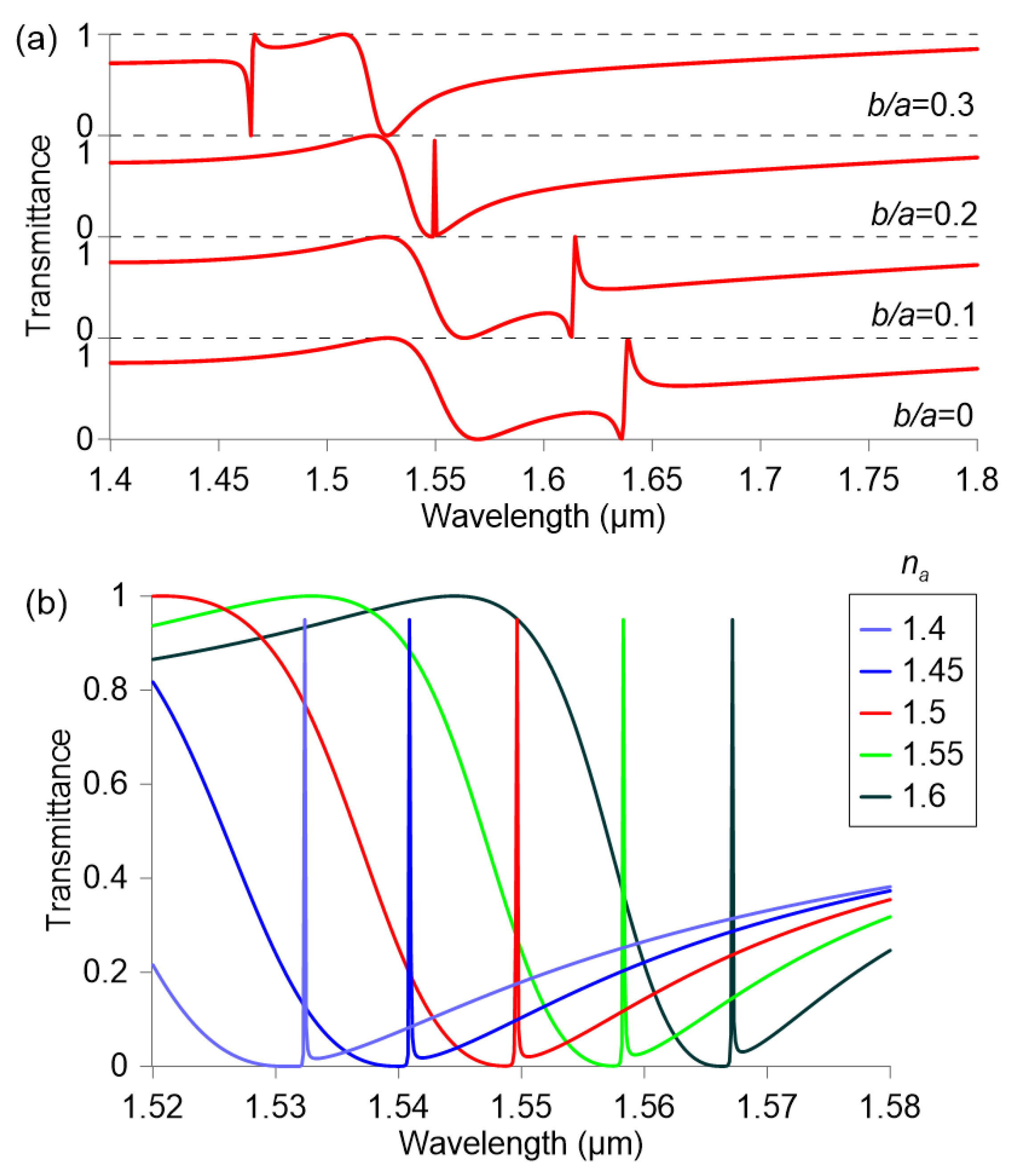
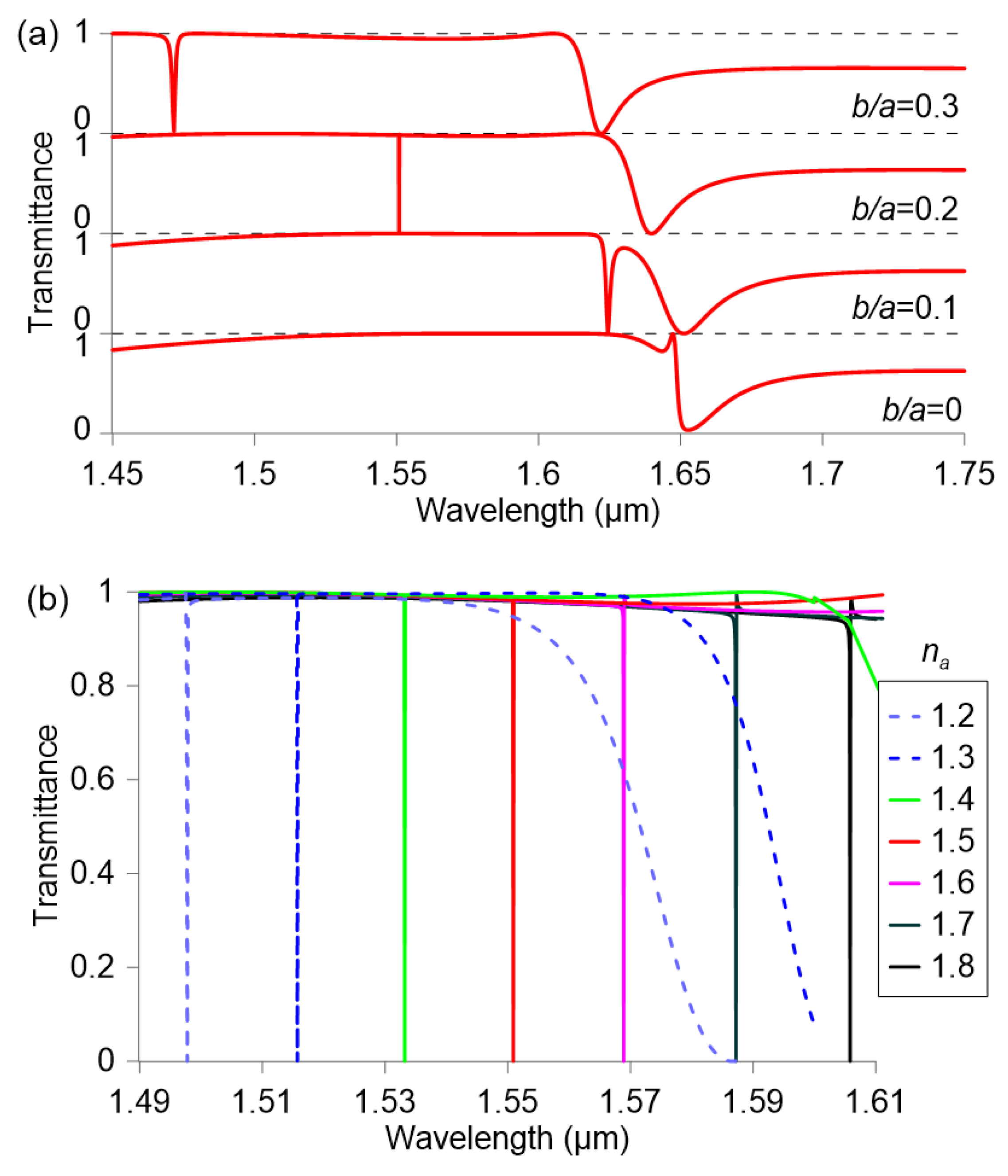
© 2018 by the authors. Licensee MDPI, Basel, Switzerland. This article is an open access article distributed under the terms and conditions of the Creative Commons Attribution (CC BY) license (http://creativecommons.org/licenses/by/4.0/).
Share and Cite
Algorri, J.F.; Zografopoulos, D.C.; Ferraro, A.; García-Cámara, B.; Vergaz, R.; Beccherelli, R.; Sánchez-Pena, J.M. Anapole Modes in Hollow Nanocuboid Dielectric Metasurfaces for Refractometric Sensing. Nanomaterials 2019, 9, 30. https://doi.org/10.3390/nano9010030
Algorri JF, Zografopoulos DC, Ferraro A, García-Cámara B, Vergaz R, Beccherelli R, Sánchez-Pena JM. Anapole Modes in Hollow Nanocuboid Dielectric Metasurfaces for Refractometric Sensing. Nanomaterials. 2019; 9(1):30. https://doi.org/10.3390/nano9010030
Chicago/Turabian StyleAlgorri, José Francisco, Dimitrios C. Zografopoulos, Antonio Ferraro, Braulio García-Cámara, Ricardo Vergaz, Romeo Beccherelli, and José Manuel Sánchez-Pena. 2019. "Anapole Modes in Hollow Nanocuboid Dielectric Metasurfaces for Refractometric Sensing" Nanomaterials 9, no. 1: 30. https://doi.org/10.3390/nano9010030
APA StyleAlgorri, J. F., Zografopoulos, D. C., Ferraro, A., García-Cámara, B., Vergaz, R., Beccherelli, R., & Sánchez-Pena, J. M. (2019). Anapole Modes in Hollow Nanocuboid Dielectric Metasurfaces for Refractometric Sensing. Nanomaterials, 9(1), 30. https://doi.org/10.3390/nano9010030






